
G B_NZ [CC BY-SA 2.0], via Wikimedia Commons
We don’t give it a second thought.
I’m here today to put that right. I’m going to explain to you why the 737 is a remarkable aircraft, how it was almost never built, how in its early years it was almost sold off as a cost cutting measure, how it has gone through a fifty year plus cycle of constant improvement and became the most built jet airliner in aviation history and will continue to be a common sight at airports around the world for many years to come.
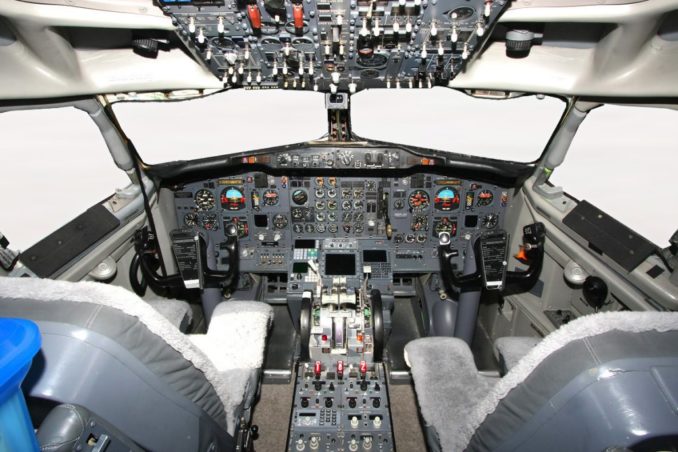
Boeing_737-200_Advanced_Cockpit_Dubai_Air_Show_Ryabtsev.jpg: Sergey Ryabtsevderivative work: Altair78 [GFDL 1.2, GFDL 1.2 or GFDL 1.2], via Wikimedia Commons
Thirty Seven Times to Uranus
Still not convinced it’s a remarkable bit of kit?
Here’s some 2014 statistics from Boeing:
- The 737 makes up over one quarter of the entire world’s airliner fleet.
- 342 airlines in 111 countries fly the 737.
- There are on average 2,000 737s in the air at any given moment.
- A 737 takes off or lands somewhere in the world every two seconds.
- There are 24,000 scheduled 737 flights across the world every day and this equates to 31% of the world’s airline traffic.
- The 737 has carried 16.8 billion passengers.
- The 737 has flown over 119 billion miles (or 37 return trips to Uranus if that’s your kind of thing).
- The 737 has racked up 184 million flights totalling 264 million flying hours (that’s over 30,000 years).
Now consider these statistics are 4-5 years out of date already and I hope you’ll begin to appreciate just how remarkable this aircraft is.
On 13th March 2018 Boeing delivered the 10,000th 737 to Southwest Airlines.
If you parked every 737 that has been built nose to tail they would make a line of aircraft 77 miles long.
Today Boeing still has orders for more than 4,600 737s on its books. It has been built in four distinct generations; the Original (sometimes also referred to as the Jurassic), the Classic, the NG (New Generation) and the latest MAX.
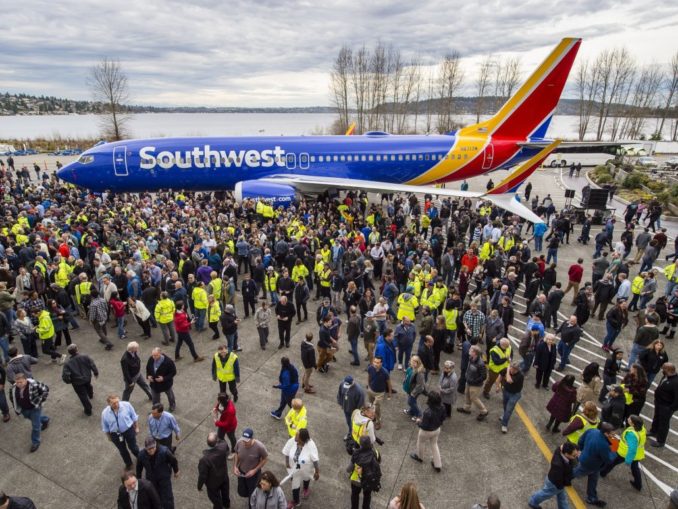
Boeing
Every Story Has a Beginning
So how did it all begin? The answer is it almost didn’t. In 1964 Boeing were doing quite well indeed. The 707 was conquering the world and the smaller 727 had just entered service. Nevertheless Boeing thought there might be a market for an even smaller jet airliner – one which could operate from smaller airports than the 727 and carry 50-60 passengers on routes up to 1,000 miles. Boeing put together a team headed up by Jack Steiner to study possible designs for such an aircraft.
Steiner’s team came up with an initial design that featured two podded engines mounted on the rear fuselage, a t-tail and five abreast passenger seating. The design was subsequently revised by an engineer on the team called Joe Sutter. Sutter moved the engines under the wings, thus allowing the fuselage structure to be lightened which then allowed the fuselage to be widened to accommodate six-abreast passenger seating. Sutter also removed the t-tail and went with a conventional layout instead.
Joe Sutter later went on to be the chief designer of the 747.
Boeing unveiled the design in late 1964 and it received a poor reception. The aircraft had quite an elaborate flap and slat arrangement to facilitate short runway operations and many believed these would result in high maintenance costs and poor reliability.
“We’re Not Sure We Want To Build Your Plane, Mr Steiner”
A Boeing management board meeting was scheduled for 1st February 1965 to decide the fate of the new aircraft. There was a distinct lack of interest from the airlines and the prospects didn’t look good. Steiner went over the head of the chief executive and directly lobbied the board members. He pressed the case that the Douglas DC-9, BAC 1-11 and Fokker F.28 were already in considerably more advanced stages of development and Boeing were about to cede a hugely important market segment to their competitors.
Steiner got his way and the board voted that day to go ahead with formally launching the Boeing 737. Eighteen days later the first order was received, 21 aircraft at a price of $67m for Lufthansa. Over the winter of 1964-65 Lufthansa had discussed with Boeing the possibility of enlarging the aircraft to accommodate 100 passengers, and Lufthansa now stipulated this be done for their order. Boeing duly complied and enlarged the original design with extra passenger capacity.
Then on 5th April an order for 40 aircraft was received from United Airlines. Again, United wanted an even larger aircraft so Steiner’s team added a 36in and 40in fuselage extension fore and aft the wings respectively. This variant became known as the 737-200 and the smaller Lufthansa variant became the 737-100.
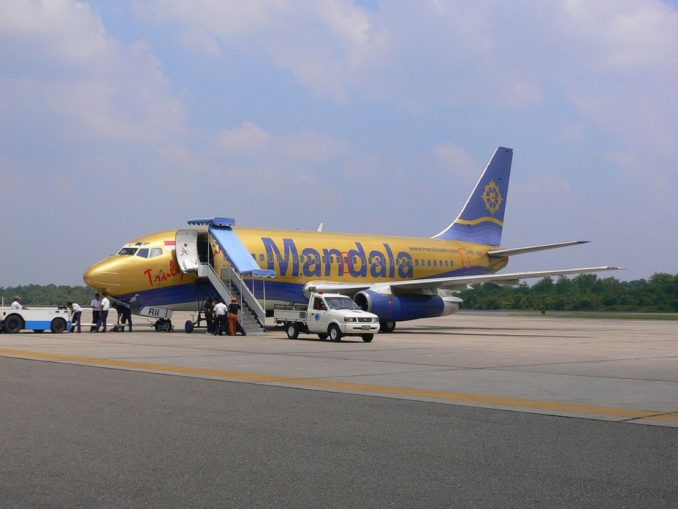
Lionlmi at English Wikipedia [CC BY-SA 3.0], via Wikimedia Commons
The 737-100 made its first flight in April 1967 and the -200 first flew in August of the same year. First revenue flights with Lufthansa and United were in February and April 1968 respectively. The 737 had arrived.
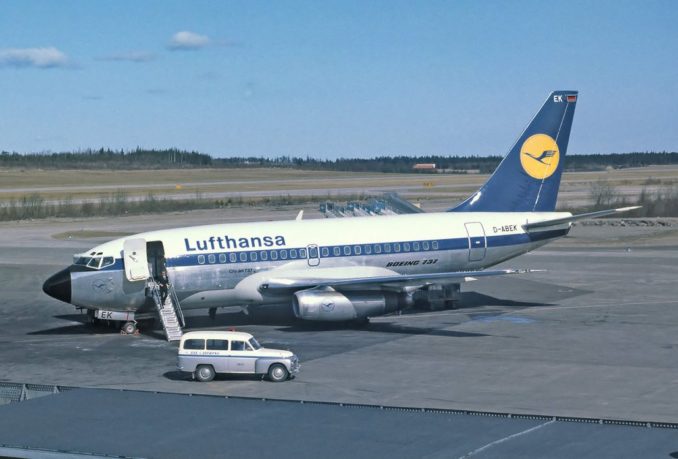
Lars Söderström [CC BY-SA 3.0], via Wikimedia Commons
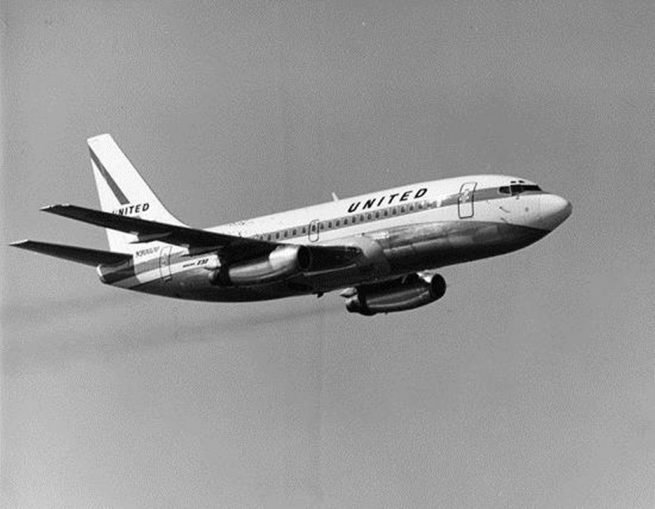
San Diego Air and Space Museum Archive [Public domain], via Wikimedia Commons
There May Be Trouble Ahead
The 737 wasn’t out of the woods yet. Not by a long shot. In the early years sales were very slow. The simple fact was the DC-9 was getting the lion’s share of orders and the 737 was left with the scraps. At this point Boeing had literally bet the farm on the new and hugely ambitious 747 and were heavily committed. The sluggish 737 sales were a drag on the company. To make things even worse a minor recession hit the US in 1969/70 and the effects were felt by Boeing. A review was ordered into the future of the 737 and a Japanese consortium were interested in buying the design from Boeing. The review concluded that the 737 should not be sold off and it had as yet unrealised sales potential. The 737 was ultimately saved by a 1971 order from the US Air Force for 19 aircraft to be used for training aircrew navigators and given the military designation T-43.
This reprieve gave the design team enough breathing room to develop new variants of the 737 in an attempt to broaden the appeal of the aircraft. First was the 737-200C (Convertible) which had removable passenger seats, a strengthened deck and a cargo door just behind the flight deck. This was followed by the 737-300QC (Quick Change) which featured a palletised passenger seating system which could be rapidly reconfigured for passenger or cargo flights. Boeing also developed a gravel kit which allowed the aircraft to be operated from unpaved gravel runways.
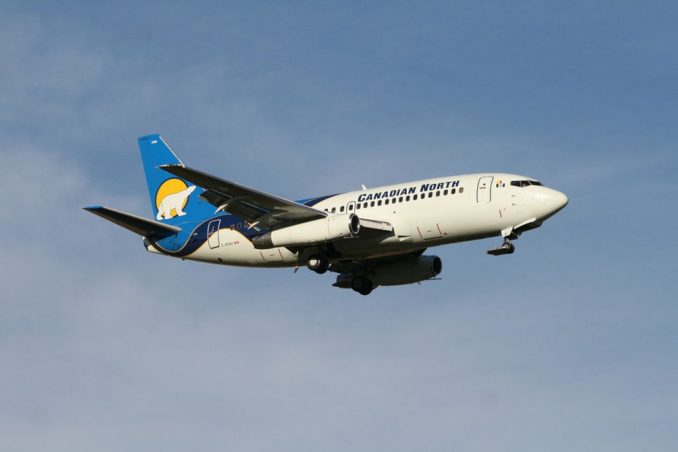
RAF-YYC from Calgary, Canada [CC BY-SA 2.0], via Wikimedia Commons
Improving The Design
Up to this point there had been several refinements made to the initial 737-200. The original aircraft had a thrust reversers very similar to the 727 and it was found on the 737 these were actually taking weight off the wheels and reducing braking effectiveness. A new arrangement was developed which avoided this problem. The attachment of the engine nacelle to the wing also received a new fairing which improved the aerodynamics and resulted in less drag. These were the most notable changes made.
In June 1971 Boeing introduced the 737-200ADV (Advanced). The ADV featured as standard all the refinements and modifications thus far. Additionally it had automatic braking for a rejected take off and added brakes to the nose wheels. Redesigned slats and flaps on the wing increased take off performance and the engines were updated to the new JT8D-15 with increased thrust allowing higher take off weights and increasing the service ceiling by 2,000ft. Later on the ADV received the even more powerful JT8D-17 and JT8D-17R. Boeing also made retrofit kits available that would turn an original 737-200 into an ADV. Following its introduction the ADV became the standard production model and went on to become the best selling member of the “Original” family. The ADV could carry a maximum of 130 passengers and had a maximum range of 2,600 nautical miles in a 120 passenger configuration.
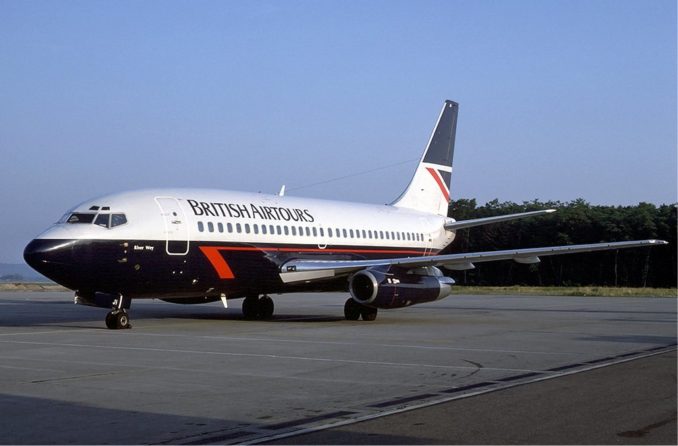
Eduard Marmet [CC BY-SA 3.0 GFDL 1.2], via Wikimedia Commons
I’ll Get The Union In Over This!
One additional interesting thing to note about the 737 is how its early sales were hindered by industrial relations and pilot’s unions. The 737 had a two-crew flight deck and dispensed with the need for a flight engineer. At the time the largest airline pilot’s union in the US stipulated all aircraft must be flown by three flight crew. For many years United were the only major operator of the 737 in the US and were forced by the union to fly with an additional and unnecessary crew member. Likewise Air France delayed ordering the 737 because it was under pressure from its pilots’ union not to buy an aircraft with a two-crew flight deck. The 737 was far from the only aircraft in this era to be affected by this issue, but it’s interesting to note how it may have hindered early sales.
In part two we’ll look at what the 1980s bought for the 737.
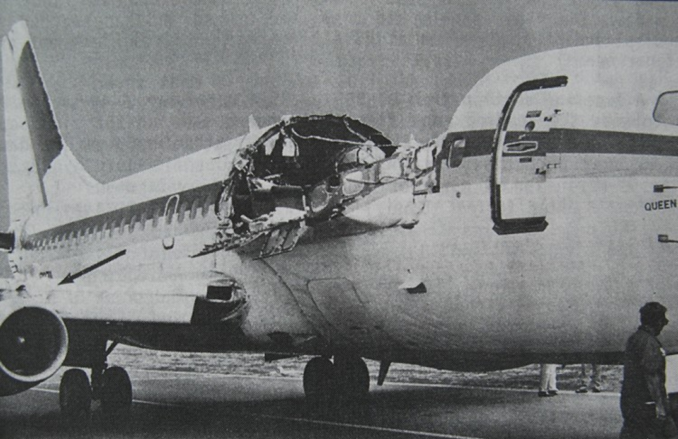
National Transportation Safety Board (NTSB) [Public domain], via Wikimedia Commons
© Æthelberht 2018

